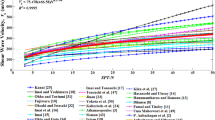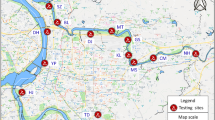Abstract
The shear-wave velocity \({V}_{S}\) a crucial parameter for determining small-strain soil stiffness characteristics and site classification. However, directly measuring \({V}_{S}\) in the field can be challenging, and requires specific equipment. As a result, researchers have conducted numerous studies on \({V}_{S}\) correlation, and extensive research has demonstrated that the results from cone penetration test (CPT) and standard penetration test (SPT) data are strongly related to the shear-wave velocity. Due to the uncertainty of the transformation model, the accuracy of the \({V}_{S}\) derived from the empirical equations are unsatisfactory. The purpose of the present paper is to propose a Bayesian framework for determining the probabilistic characteristics of \({V}_{S}\) while considering the transformation uncertainty. The Bayesian framework considers both the in-situ test data (SPT, CPT) and prior information, and the results show that the framework considering two in-situ tests accurately predicts the shear-wave velocity. There are several advantages of using the Bayesian method described in this study: (1) The Bayesian framework incorporates both the inherent uncertainty of the shear-wave velocity and the transformation uncertainty. (2) Prior information and field data can be combined to improve the accuracy of predictions. (3) In the framework, the statistical characteristics of \({V}_{S}\) can be ascertained from small samples of field test data.














Similar content being viewed by others
Data availability statements
The datasets generated during the current study are available from the corresponding author on reasonable request.
References
Adamo F et al (2010) Soil moisture assessment by means of compressional and shear-wave velocities: theoretical analysis and experimental setup. Measurement 43(3):344–352
Anbazhagan P, Parihar A, Rashmi HN (2012) Review of correlations between SPT N and shear modulus: a new correlation applicable to any region. Soil Dynam Earthquake Eng 36:52–69
Cai G, Puppala AJ, Liu S (2014) Characterization on the correlation between shear-wave velocity and piezocone tip resistance of Jiangsu clays. Eng Geol 171:96–103
Cao Z-J, Wang Y, Li D-Q (2016) Site-specific characterization of soil properties using multiple measurements from different test procedures at different locations – A Bayesian sequential updating approach. Eng Geol 211:150–161
Ching J, Phoon K-K, Chen Y-C (2010) Reducing shear strength uncertainties in clays by multivariate correlations. Can Geotech J 47(1):16–33
Dikmen Ü (2009) Statistical correlations of shear-wave velocity and penetration resistance for soils. J Geophys Eng 6(1):61–72
Fabbrocino S et al (2015) SPT blow count vs. shear-wave velocity relationship in the structurally complex formations of the Molise Region (Italy). Eng Geol 187:84–97
Fayed AL, Mousa AA (2020) Shear-wave velocity in the east nile delta clay: correlations with static CPT Measurements. Geotech Geol Eng 38(2):2303–2315. https://doi.org/10.1007/s10706-019-01089-4
Hasancebi N, Ulusay R (2007) ‘Empirical correlations between shear-wave velocity and penetration resistance for ground shaking assessments. Bull Eng Geol Environ 66(2):203–213
Jianye C, Kwang PK, Hsuan WS (2016) Impact of statistical uncertainty on geotechnical reliability estimation. J Eng Mech 142(6):04016027
Karray M, Hussien MN (2017) Shear-wave velocity as function of cone penetration resistance and grain size for Holocene-age uncemented soils: a new perspective. Acta Geotechnica 12(5):1129–1158
Karray M, Hussien MN (2017) Why is there a discrepancy in shear-wave velocity – cone tip resistance (Vs–qc) correlations’ trends with respect to grain size? Can Geotech J 55(7):1041–1047
Kayabali K (1996) Soil liquefaction evaluation using shear-wave velocity. Eng Geol 44(1):121–127
Kruiver PP et al (2021) Rigorous test of the performance of shear-wave velocity correlations derived from CPT soundings: a case study for Groningen, the Netherlands. Soil Dynam Earthquake Eng 140:106471. https://doi.org/10.1016/j.soildyn.2020.106471
Lin S et al (2023) Genetic-simulated annealing optimization for surface wave inversion of shear-wave velocity profiles of geotechnical sites. Comput Geotech 160:105525. https://doi.org/10.1016/j.compgeo.2023.105525
Lin S, Ashlock J, Li B (2022) Direct estimation of shear-wave velocity profiles from surface wave investigation of geotechnical sites. Géotechnique 72(11):1016–1024. https://doi.org/10.1680/jgeot.20.P.258
Liu J et al (2022) Bayesian estimation for probability distribution of rock’s elastic modulus based on compression wave velocity and deformation warning for large underground cavern. Rock Mech Rock Eng 55(6):3749–3767. https://doi.org/10.1007/s00603-022-02801-2
McGann CR, Bradley BA, Taylor Merrick L, Wotherspoon LM et al (2015) Applicability of existing empirical shear-wave velocity correlations to seismic cone penetration test data in Christchurch New Zealand. SOIL DYNAMICS AND EARTHQUAKE ENGINEERING 75:76–86. https://doi.org/10.1016/j.soildyn.2015.03.021
McGann CR, Bradley BA, Taylor ML et al (2015) Development of an empirical correlation for predicting shear-wave velocity of Christchurch soils from cone penetration test data. Soil Dynam Earthquake Eng 75:66–75. https://doi.org/10.1016/j.soildyn.2015.03.023
McGann CR, Bradley BA, Jeong S (2018) Empirical correlation for estimating shear-wave velocity from cone penetration test data for banks peninsula loess soils in Canterbury, New Zealand. J Geotech Geoenviron Eng 144(9):4018054. https://doi.org/10.1061/(ASCE)GT.1943-5606.0001926
Park CB, Miller RD, Xia J (1999) Multichannel analysis of surface waves. Geophysics 64(3):800–808
Phoon K-K, Kulhawy FH (1999) Characterization of geotechnical variability. Can Geotech J 36(4):612–624. https://doi.org/10.1139/t99-038
Phoon K-K, Kulhawy FH (1999) Evaluation of geotechnical property variability. Can Geotech J 36(4):625–639. https://doi.org/10.1139/t99-039
MCBBSeokho RAJ (2018) Empirical correlation for estimating shear-wave velocity from cone penetration test data for banks peninsula loess soils in Canterbury, New Zealand. J Geotech Geoenviron Eng 144(9):04018054
Robertson PK (2009) Interpretation of cone penetration tests — a unified approach. Can Geotech J 46(11):1337–1355
Roy N et al (2018) Effect of uncertainty in \(V_{\mathrm{S}}{-}N\) correlations on seismic site response analysis. J Earth Syst Sci 127(7):103
Shen M-Y et al (2018) ‘Probabilistic characterization of site-specific inherent variability of undrained shear strength using both indirect and direct measurements. ASCE-ASME J Risk and Uncertainty in Eng Syst Part A Civil Eng. https://doi.org/10.1061/AJRUA6.0000941
Taylor O-DS, Abdollahi M, Vahedifard F (2022) Statistical distributions of wave velocities and elastic moduli in near-surface unsaturated soils. Soil Dynam Earthquake Eng 157:107247
Thokchom S et al (2017) Empirical correlation of SPT blow counts versus shear-wave velocity for different types of soils in Dholera, Western India. Natural Hazards 86(3):1291–1306
Tong L et al (2019) Comparison of shear-wave velocity prediction models to yangtze river deltaic sediments based on piezocone test data. Int J Civil Eng 17(12):1845–1858. https://doi.org/10.1007/s40999-019-00408-3
Tong LY et al (2018) Determination of shear-wave velocity of Yangtze Delta sediments using seismic piezocone tests. Trans Geotech 14:29–40. https://doi.org/10.1016/j.trgeo.2017.09.005
Wang Y, Akeju OV (2016) Quantifying the cross-correlation between effective cohesion and friction angle of soil from limited site-specific data. Soils and Foundations 56(6):1055–1070. https://doi.org/10.1016/j.sandf.2016.11.009
Wang Y, Akeju OV, Cao Z (2016) Bayesian Equivalent Sample Toolkit (BEST): an Excel VBA program for probabilistic characterisation of geotechnical properties from limited observation data. Georisk 10(4):251–268
Wang Y, Aladejare AE (2015) Selection of site-specific regression model for characterization of uniaxial compressive strength of rock. Int J Rock Mech Mining Sci 75:73–81
Wang Y, Aladejare AE (2016) Bayesian characterization of correlation between uniaxial compressive strength and Young’s modulus of rock. Int J Rock Mech Mining Sci 85:10–19. https://doi.org/10.1016/j.ijrmms.2016.02.010
Wang Y, Cao Z (2013) Probabilistic characterization of Young’s modulus of soil using equivalent samples. Eng Geol 159:106–118. https://doi.org/10.1016/j.enggeo.2013.03.017
Wang Y, Cao Z, Li D (2016) Bayesian perspective on geotechnical variability and site characterization. Eng Geol 203:117–125. https://doi.org/10.1016/j.enggeo.2015.08.017
Wang Y, Zhao T (2017) Bayesian assessment of site-specific performance of geotechnical design charts with unknown model uncertainty. Int J Num Anal Methods in Geomech 41(5):781–800
Wang Y, Zhao T, Cao Z (2015) Site-specific probability distribution of geotechnical properties. Comput Geotech 70:159–168
Xu D et al (2020) Bearing capacity analysis of offshore pipe piles with CPTs by considering uncertainly. Comput Geotech 126:103731. https://doi.org/10.1016/j.compgeo.2020.103731
Yang Z et al (2021) Effect of silt/clay content on shear-wave velocity in the Yellow River Delta (China), based on the cone penetration test (CPT). Bull Eng Geol Environ 81(1):28. https://doi.org/10.1007/s10064-021-02520-y
Zhang J, Zhang LM, TW H (2009) Bayesian framework for characterizing geotechnical model uncertainty. J Geotech Geoenviron Eng 135(7):932–940
Zhang L et al (2018) Bayesian model comparison and characterization of bivariate distribution for shear strength parameters of soil. Comput Geotech 95:110–118
Zhang L et al (2018) Bayesian model comparison and characterization of bivariate distribution for shear strength parameters of soil. Comput Geotech 95:110–118. https://doi.org/10.1016/j.compgeo.2017.10.003
Zhang M, Tong L (2017) New statistical and graphical assessment of CPT-based empirical correlations for the shear-wave velocity of soils. Eng Geol 226:184–191. https://doi.org/10.1016/j.enggeo.2017.06.007
Zhao Z et al (2022) Bayesian probabilistic characterization of consolidation behavior of clays using CPTU data. Acta Geotechnica 17(3):931–948. https://doi.org/10.1007/s11440-021-01277-8
Acknowledgements
The authors gratefully acknowledge the financial support from National Natural Science Foundation of China (Grant Nos. 42277153, 41977241 and 52008098) and the Natural Science Foundation of Jiangsu Province (Grant No. BK20200405). The authors would like to express their appreciations to the editors and anonymous reviewers for their valuable comments and suggestions.
Funding
The authors have not disclosed any funding.
Author information
Authors and Affiliations
Contributions
Shijie Zhai and Guanyin Du wrote the main manuscript text. Huan He was responsible for the language changes.
Corresponding author
Ethics declarations
Competing interests
The authors declare no competing interests.
Additional information
Publisher's Note
Springer Nature remains neutral with regard to jurisdictional claims in published maps and institutional affiliations.
Supplementary Information
Below is the link to the electronic supplementary material.
Rights and permissions
Springer Nature or its licensor (e.g. a society or other partner) holds exclusive rights to this article under a publishing agreement with the author(s) or other rightsholder(s); author self-archiving of the accepted manuscript version of this article is solely governed by the terms of such publishing agreement and applicable law.
About this article
Cite this article
Zhai, S., Du, G. & He, H. Bayesian probabilistic characterization of the shear-wave velocity combining the cone penetration test and standard penetration test. Stoch Environ Res Risk Assess 38, 69–84 (2024). https://doi.org/10.1007/s00477-023-02566-2
Accepted:
Published:
Issue Date:
DOI: https://doi.org/10.1007/s00477-023-02566-2




